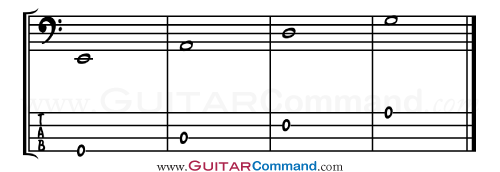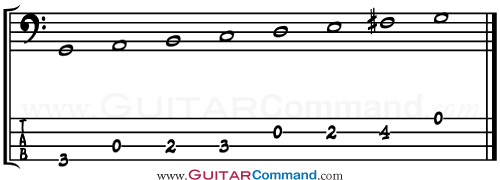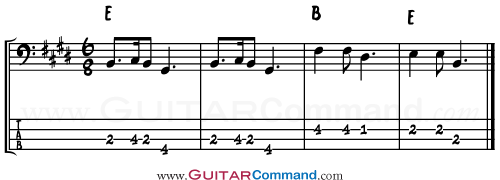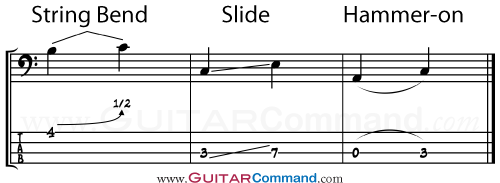This lesson will teach you how to read bass tab. Tab is short for tablature, a system used to show how music should be played on fretted instruments. It is in common use today, but is not a recent invention. Tablature has been in use for hundreds for years. Tab is popular among beginner bassists because it is easier to read than traditional musical notation and can be learned in a very short space of time.
How To Read Bass Tab

In tab, the horizontal lines represent the strings. If the part is written for a standard four string bass then there will be four horizontal lines, one for each string. The bottom line of tab represents the E string, the top line represents the G string. The second and third lines represent the A and D strings respectively.
Tab Numbers
The numbers on the tab show the fret at which the string should be held down in order to play the desired note. A zero means that the string should be played open, without any notes being held down.
Bar lines appear in tab as vertical lines, just as they do in standard notation.
Tab is usually included under standard notation. Tab can also be written on its own, without the standard notation. Many online guitar tab sites feature tabs written with text characters. Although easy to produce, text tab can be harder to understand. When learning how to read bass tab it is a good idea to see how it relates to the notation.
Bass Tab Open Strings & Scales
Below is tab showing the open strings of a bass guitar:

The diagram below shoes how a G major scale is notated in tab.

The first note is played at the third fret of the E (lowest) string. The second note is the open A string. The third is the second fret of the A string, and so on.
Bass Tab Examples
The best way to learn how to read bass tab is to play tunes that you already know and see how they have been written in tab.


Rhythm In tab
One of the limitations of tab is that it does not include rhythmic information. Most tab parts do not show how long the notes are and when they should be played. This is why tab is generally best used when you already have an idea of how the music goes, or when the rhythm is simple. Occasionally, rhythmic lines are shown on the tab part, but these are not always accurate, and can often be more confusing than helpful.
Because tab numbers are positioned directly below their notation counterparts, and notation is usually spaced roughly according to the rhythm of the music, you can get an idea of the rhythm of the part. When you become aware of the limitations of tab, you should start to learn to read notation. Even having a basic idea of note rhythms will be a big help reading bass lines.
Other Symbols
Tab does not only show notes. Other musical information can be included. Symbols can differ from publisher to publisher and from website to website, but the following symbols are in common use.

Hammer-Ons and Pull-offs
Hammer-ons and pull-offs occur where one note is picked and the next note(s) are sounded by fretting the same string without the string being picked again. A hammer-on is when the next note is higher than the original note, a pull-off when it is lower. In printed tab, hammer-ons and pull-offs are represented by curved lines over two or more notes. In text tab, hammer-ons and pull-offs are represented with an 'h' or a 'p' between two notes. In text tab, an alternative way to show hammer-ons and pull-offs is by using a '^' between two notes.
Slides
Slides are represented by lines that slope either up or down depending on whether the destination note is higher or lower. If the destination note is not to be picked, a curved line is also placed over the notes. In text tab the forward '/' and back'\' slash symbols are used to show slides.
String Bends
Arrows are used to show string bends. The extent of the bend is shown with a small number. '1/2' means that the string is to be bent upwards a half-step, a '1' means a whole step. '1/4' can be used to represent a slight bend. If the bent note is to be released and the original note sounded, a downwards pointing arrow is used. In text tab, bends are shown between two fret numbers as 'b' for bend, and 'r' for release.
Muffled strings.
An X is used to represent the effect of muffling a string to produce a rhythmic sound.
How To Read Bass Tab Conclusion
It is not hard to learn how to play bass tab. By playing famous melodies and tunes that you already know you will pick it up very quickly. Text tabs from the internet can be hard to follow and inaccurate. However, they're plentiful and usually free, so are a good resource as you learn! Find out more about the history of tablature here.
Over To You...
Have you got any tips on how to read bass tab? Do you read traditional notation too? Let us know!


How do you convert or play the Bass notes on a electric guitar? A guitar has 6 strings. EADGBE. How do I know which number on a Bass Tab represent the note on a guitar?
Hi, good question.
The strings on a bass are the same pitches as the lowest four strings on a guitar, but an octave lower.
Therefore, you should view the bass tab as being exactly the same as guitar tab, but with the top two guitar strings missing.
Of course, when you play bass tab on guitar, all the notes you hear will be an octave higher than they’re supposed to be.
Hope this helps.
Regards,
The Guitar Command Team
In some tabs, I see what looks like ‘/ The dot and backslash kind of resemble a 7 What does that mean?
Hi Daniel,
It’s difficult to be sure without knowing the context of the music. Is this on the tab part or the music part (if there is a music part). Tabs aren’t quite standard, so some symbols may be unique to whoever produced the tab and might mean different things to different people.
Sorry we can’t be more help.
Regards,
The Guitar Command Team
In a song I’m trying to learn there is a 2r5r and so on what does that mean?
Hi Jayson,
It’s difficult to be sure without knowing the context of the music. It might mean play with the right hand, or could be something completely different – if you can give us more to go on we’d be happy to take another look.
Regards,
The Guitar Command Team
when you see a 3 then a (3) how do you play the 2nd ‘3’ ?? or
saw a % in tab, what does this mean?
Hi,
Thank you for your comment.
IF you see a symbol that looks like a large percentage sign in music, it means repeat the previous measure.
Hope this helps,
The Guitar Command Team
On some bass tabs I’m finding there is a “~” symbol. What does that mean?
That’s sustain, so leave it ring instead of muting the string. You may also need to play the string a bit harder in order to make it last long enough.
It was very helpful.but doesit also apply to a five string guitar?
Hi,
Good question. It’s exactly the same principle, but TAB for 5-string bass guitar will have 5 horizontal strings to represent the instrument’s 5 strings.
We’re currently updating all of the content on the site, and we’ll try to cover 5 string TAB in more detail in a future article.
Best of luck with your playing,
The Guitar Command Team.
i still have no idea what the numbers mean on the tabs.
Hi Mikaela,
Assuming you’re playing a standard bass guitar…
The numbers on the TAB represent the fret at which a finger of your left hand should hold down the string in order to play the desired note.
For example, if you see a ‘3’ on the lowest line on the TAB, then hold your bass’s lowest (bottom E) string down at the 3rd fret, then play the note with your right hand (either using your finger or with a pick).
(This will result in a ‘G’ note.)
I hope this helps. We’re currently in the process or re-writing much of our old content, this page included. Please check back soon and hopefully things will be clearer!
Regards,
Guitar Command Admin